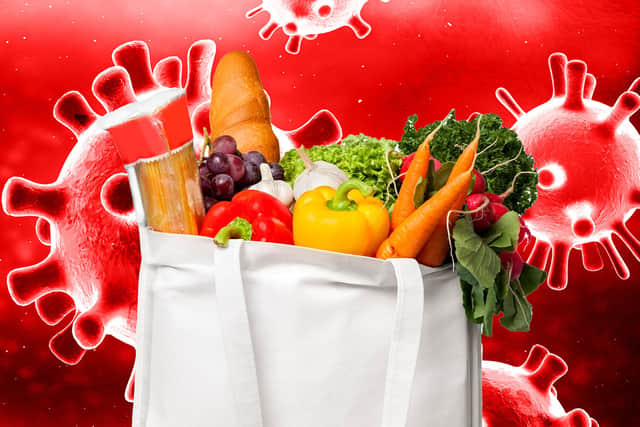Can Covid survive on food? New research claiming virus can stay on some groceries explained
and live on Freeview channel 276
The virus that causes Covid-19 can live on some ready-to-eat groceries for days, experts have found. But what items can Covid live on and what did research find? Here’s what you need to know.
What food can Covid live on?
The tests were carried out for the Food Standards Agency in a laboratory. The research found the SARS-CoV-2 virus smeared on packaging and food including fruit and bottled drinks that people might put in their mouth without cooking or washing.
Advertisement
Hide AdAdvertisement
Hide AdThe results varied, with most foods tested having a significant drop in levels of virus contamination over the first 24 hours. But for peppers, bread crust, ham and cheese the infectious virus was detected for several days under some conditions, while it was present for several hours on the surfaces of croissants and pain au chocolat.
For most food products tested there was a "significant drop" in the levels of virus over the first 24 hours. But in some cases traces survived for about a week, the University of Southampton team found.
The team examined a range of temperatures and humidity levels to mimic typical storage conditions, measuring the rate of inactivation of the virus. The virus appears to last longer on produce with uneven surfaces - such as broccoli and raspberries - than on smooth skinned ones such as apples. However, some chilled fresh peppers had detectable virus a week later.
Pastries such as pain au chocolat appeared to have little virus after a few hours. Scientists said this may be because they are coated in a fine layer of egg wash during baking.
Advertisement
Hide AdAdvertisement
Hide AdCheese and cold meat, with a high protein and fat content, appear to allow the virus to survive for days - possibly up to a week. Meanwhile, Covid can survive for up to a week on plastic surfaces. Researchers said that for cartons, the virus could survive for several days and for aluminium cans, it is probably only hours.


What did researchers say?
The researchers said: "For a highly infectious agent such as Sars-Cov-2, which can be transmitted through touching contaminated surfaces and then the face, these findings are highly noteworthy.”
However, the study’s authors said foods and packaging used in the study were “artificially inoculated with SARS-CoV-2 and therefore are not a reflection of contamination levels found on these foods at retail, and lower levels of contamination will require less time to decline to undetectable levels”. They added: “The public may be interested in the finding that virus may persist in an infectious state, on foods and food packaging surfaces, for several days under certain common conditions.”
The authors said the results of the study “reinforce the need to rigorously follow the guidance on maintaining appropriate hygienic handling measures and display of unpackaged foods”. However, the scientists have advised the risk to consumers remains very low.
Advertisement
Hide AdAdvertisement
Hide AdAnthony Wilson, microbiological risk assessment team leader at the FSA, said: "In the early stages of the pandemic, we didn’t know much about how the virus would survive on different food surfaces and packaging, so the risk assessment was based on a worst-case assumption. This research gives us additional insight into the stability of coronavirus on the surfaces of a variety of foods and confirms that assumptions we made in the early stages of the pandemic were appropriate, and that the probability that you can catch Covid via food is very low."
Comment Guidelines
National World encourages reader discussion on our stories. User feedback, insights and back-and-forth exchanges add a rich layer of context to reporting. Please review our Community Guidelines before commenting.
